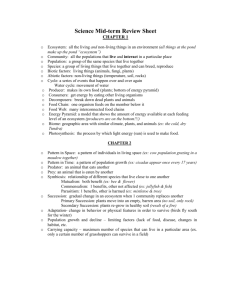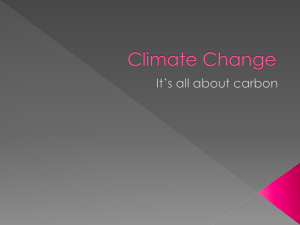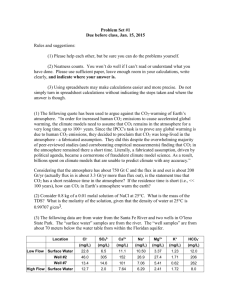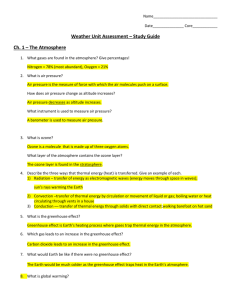Answers to review questions
advertisement
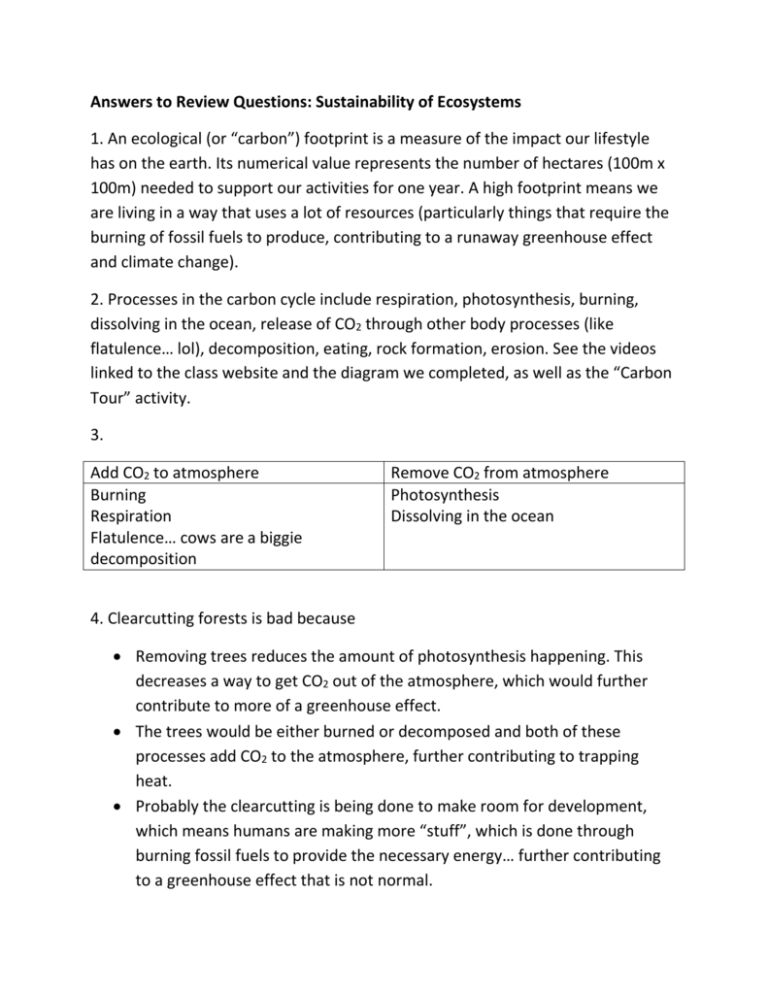
Answers to Review Questions: Sustainability of Ecosystems 1. An ecological (or “carbon”) footprint is a measure of the impact our lifestyle has on the earth. Its numerical value represents the number of hectares (100m x 100m) needed to support our activities for one year. A high footprint means we are living in a way that uses a lot of resources (particularly things that require the burning of fossil fuels to produce, contributing to a runaway greenhouse effect and climate change). 2. Processes in the carbon cycle include respiration, photosynthesis, burning, dissolving in the ocean, release of CO2 through other body processes (like flatulence… lol), decomposition, eating, rock formation, erosion. See the videos linked to the class website and the diagram we completed, as well as the “Carbon Tour” activity. 3. Add CO2 to atmosphere Burning Respiration Flatulence… cows are a biggie decomposition Remove CO2 from atmosphere Photosynthesis Dissolving in the ocean 4. Clearcutting forests is bad because Removing trees reduces the amount of photosynthesis happening. This decreases a way to get CO2 out of the atmosphere, which would further contribute to more of a greenhouse effect. The trees would be either burned or decomposed and both of these processes add CO2 to the atmosphere, further contributing to trapping heat. Probably the clearcutting is being done to make room for development, which means humans are making more “stuff”, which is done through burning fossil fuels to provide the necessary energy… further contributing to a greenhouse effect that is not normal. The energy required to DO the clearcutting (heavy machinery) burns fossil fuels and releases carbon emissions into the atmosphere. Bad, yo. 5. On Earth, a greenhouse effect is necessary to support life… it helps Earth have the right temperature to allow organisms to live… but it is quickly becoming a “runaway greenhouse effect” through positive feedback due to human activities. If we don’t change our paradigm, Earth could eventually wind up like Venus… ridiculously hot temperatures, an atmosphere of sulfuric acid, thick cloud cover, and unable to support any life. 6. Positive feedback is anything where the effect of doing an action serves to further cause that effect. Examples: Melting icecaps reduces the amount of “white” in the Arctic. Less white means less reflection of the sun’s radiation. More heat is absorbed. So more melting happens. This cycle continues to feed itself. Clearcutting plants and trees causes erosion because their roots are no longer there to keep the soil in place. Without good soil, plants cannot grow, causing further erosion due to lack of plants. Melting permafrost releases lots of methane (CH4) into the atmosphere which was trapped in it from millions of years ago when it formed. Methane is a BIG greenhouse gas (way more powerful than CO2) and contributes to further heating of the earth, making even more melting happen. 7. Sustainability in an ecosystem means that the ecosystem can support a wide variety of organisms for a long time. 8. Biodiversity is a measure of the VARIETY of organisms in an ecosystem. High biodiversity is good. It can prevent the spread of disease, it increases variability within and among species, it means there are lots of resources to support organisms… in other words, it’s kind of a positive feedback situation where diversity contributes to more diversity. 9. Most biodiverse Coral reef and rainforest… large variety of plants, animals, colors, lifestyles Temperate forest Tundra Desert, prairie, savanna… much less variety in plants and animals, fewer colors and lifestyles seen Least biodiverse 10. Bioaccumulation Buildup in a single organism Buildup due to toxins being fat soluble and not being excreted out with waste products Both Buildup of toxins over time Biomagnification Buildup through the food chain (producer = least, top carnivore = most) Buildup due to eating habits and nutrient transfer during feeding 11. Venn diagram is hard in a typed document… refer to the chart handout on long paper. 12. Eagles would be most affected because they are the highest on the food chain. Plants are producers, frogs and trout are secondary consumers and eagles are tertiary consumers. Biomagnification will happen as we move up the food chain. 13. An ecological niche is the particular role an organism plays in its ecosystem. It includes predator/prey relationships, symbiosis, and competition. The arctic hare (see the food web from the Save the Ermines! Assignment) has a role as a primary consumer. It consumes grass and willows and keeps the population of these species down to a reasonable level. At the same time, they are a food source for the ermines , fox, wolf and other secondary or tertiary consumers. Meanwhile, their decomposing remains provide a food source for a variety of bugs. If we removed the arctic hare from the ecosystem, a trophic cascade would result. 14. A trophic cascade is when a change with one species has drastic impacts on other species, even several “links” away on a food web. An example is with the addition of wolves back into the Yellowstone Park ecosystem. Wolves meant that the elk population went down. Fewer elk meant that the willows could grow, since fewer elk were eating them. This made a good habitat for birds. Beavers flourished because they now had branches for dam building. This flooded areas and created ponds for fish. Bugs thrived on the dead elk carcasses. 15. People have shifted from using pesticides to finding natural ways to take care of their lawn. Laws have been made to support this. Most people recycle paper and compost here in NS. 16. biotic: competition, predation, symbiosis Abiotic: space, oxygen, water, soil, nutrients, climate 17. Answers vary but be sure to give detail as in #14 as to WHY certain things would happen.


